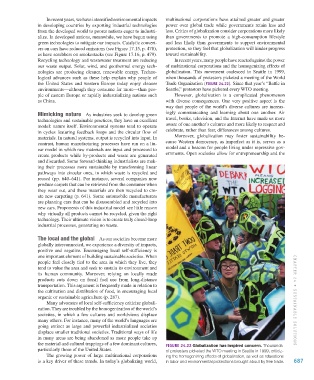Page 688 - Environment: The Science Behind the Stories
P. 688
In recent years, we have intensified environmental impacts multinational corporations have attained greater and greater
in developing countries by exporting industrial technologies power over global trade while governments retain less and
from the developed world to poorer nations eager to industri- less. Critics of globalization consider corporations more likely
alize. In developed nations, meanwhile, we have begun using than governments to promote a high-consumption lifestyle
green technologies to mitigate our impacts. Catalytic convert- and less likely than governments to support environmental
ers on cars have reduced emissions (see Figure 17.15, p. 478), protection, so they feel that globalization will hinder progress
as have scrubbers on smokestacks (see Figure 17.16, p. 479). toward sustainability.
Recycling technology and wastewater treatment are reducing In recent years, many people have reacted against the power
our waste output. Solar, wind, and geothermal energy tech- of multinational corporations and the homogenizing effects of
nologies are producing cleaner, renewable energy. Techno- globalization. This movement coalesced in Seattle in 1999,
logical advances such as these help explain why people of when thousands of protestors picketed a meeting of the World
the United States and western Europe today enjoy cleaner Trade Organization (Figure 24.22). Since that year’s “Battle in
environments—although they consume far more—than peo- Seattle,” protestors have picketed every WTO meeting.
ple of eastern Europe or rapidly industrializing nations such However, globalization is a complicated phenomenon
as China. with diverse consequences. One very positive aspect is the
way that people of the world’s diverse cultures are increas-
Mimicking nature As industries seek to develop green ingly communicating and learning about one another. Air
technologies and sustainable practices, they have an excellent travel, books, television, and the Internet have made us more
model: nature itself. Environmental systems tend to operate aware of one another’s cultures and more likely to respect and
in cycles featuring feedback loops and the circular flow of celebrate, rather than fear, differences among cultures.
materials. In natural systems, output is recycled into input. In Moreover, globalization may foster sustainability be-
contrast, human manufacturing processes have run on a lin- cause Western democracy, as imperfect as it is, serves as a
ear model in which raw materials are input and processed to model and a beacon for people living under repressive gov-
create products while by-products and waste are generated ernments. Open societies allow for entrepreneurship and the
and discarded. Some forward-thinking industrialists are mak-
ing their processes more sustainable by transforming linear
pathways into circular ones, in which waste is recycled and
reused (pp. 640–641). For instance, several companies now
produce carpets that can be retrieved from the consumer when
they wear out, and these materials are then recycled to cre-
ate new carpeting (p. 641). Some automobile manufacturers
are planning cars that can be disassembled and recycled into
new cars. Proponents of this industrial model see little reason
why virtually all products cannot be recycled, given the right
technology. Their ultimate vision is to create truly closed-loop
industrial processes, generating no waste.
The local and the global As our societies become more
globally interconnected, we experience a diversity of impacts,
positive and negative. Encouraging local self-sufficiency is
one important element of building sustainable societies. When
people feel closely tied to the area in which they live, they
tend to value the area and seek to sustain its environment and
its human community. Moreover, relying on locally made
products cuts down on fossil fuel use from long-distance
transportation. This argument is frequently made in relation to
the cultivation and distribution of food, in encouraging local
organic or sustainable agriculture (p. 287).
Many advocates of local self-sufficiency criticize globali- CHAPTER 24 • Su STA in A bl E Sol u T i on S
zation. They are troubled by the homogenization of the world’s
societies, in which a few cultures and worldviews displace
many others. For instance, many of the world’s languages are
going extinct as large and powerful industrialized societies
displace smaller traditional societies. Traditional ways of life
in many areas are being abandoned as more people take up
the material and cultural trappings of a few dominant cultures, Figure 24.22 Globalization has inspired concern. Thousands
particularly those of the United States. of protesters picketed the WTO meeting in Seattle in 1999, criticiz-
The growing power of large multinational corporations ing the homogenizing effects of globalization, as well as relaxations
is a key driver of these trends. In today’s globalizing world, in labor and environmental protections brought about by free trade. 687
M24_WITH7428_05_SE_C24.indd 687 13/12/14 10:40 AM

